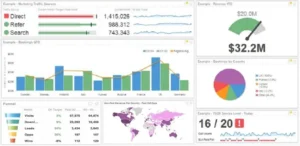Standardizing data is crucial for any organization that uses Salesforce. Standardization means ensuring data is consistently and uniformly entered in a database, following consistent rules or guidelines.
One of the most essential aspects of standardizing data is to use standard names and abbreviations for geographical locations, such as states, cities, and counties. For example, Ohio should always be spelled “Ohio” and not abbreviated as “OH” or any other variation. This may seem like a minor detail, but it can significantly impact the accuracy and usefulness of reports generated from the CRM database. Imagine the chaos for all fifty states entered in these two ways. What if you joined Mr. or Mrs. in front of a name but then just first name and last name in other entries—chaos ensues.
When data is standardized, analyzing and generating reports that provide valuable insights into customer behavior, sales trends, and other essential business metrics becomes simpler. Standardized data also improves data quality, enhancing decision-making, reducing errors, and minimizing the risk of duplicate data.
In the case of Ohio, being abbreviated as “OH,” for example, can lead to inconsistent data entry, making it difficult to track sales or customer behavior in that state accurately. It could also compound confusion when generating reports that include data from multiple sources, as different people may use various abbreviations or spelling variations.
In summary, standardizing data is essential for ensuring the accuracy and usefulness of CRM databases and the reports generated from them. Organizations can improve their decision-making, enhance customer experiences, and drive business growth by using consistent naming conventions and other standardization techniques.
Valuable Tips for Standardizing CRM Data
In a perfect world, these customizations adapt Salesforce to the unique needs of each business, elevate productivity, improve data management, and enable efficient sales, marketing, and customer service activities.
- Define data standards: Start by defining clear and consistent data standards for your organization. Establish naming conventions, formatting rules, and other guidelines for entering data into the CRM system.
- Use drop-down menus: Use drop-down menus wherever possible to minimize the risk of data entry errors and to ensure consistent data entry. This can help to standardize data across multiple users and departments.
- Enforce data entry rules: Use validation rules to enforce data entry rules, such as mandatory fields, maximum and minimum character counts, and formatting requirements. This can help to ensure that data is entered accurately and consistently.
- Cleanse and de-duplicate data: Regularly cleanse and de-duplicate your CRM data to remove any inconsistencies and duplicate records. This can help to improve data quality and ensure that reports generated from the system are accurate and useful. Do this at a minimum of once a year.
- Provide training and support: Provide training and support to users to ensure they understand the importance of standardizing data and how to enter data consistently. This can help to ensure that data is entered accurately and consistently across the organization.
- Monitor data quality: Regularly spot-check data quality to identify issues or inconsistencies. This can help to identify areas where additional training or support may be needed to improve data standardization.







